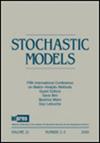Stationary workload and service times for some nonwork-conserving M/G/1 preemptive LIFO queues
IF 0.7
4区 数学
Q4 STATISTICS & PROBABILITY
引用次数: 0
Abstract
Abstract We analyze two nonwork-conserving variations of the M/G/1 preemptive last-in first-out (LIFO) queue with emphasis on deriving explicit expressions for the limiting (stationary) distributions of service times found in service by an arrival, workload and a variety of related quantities of interest. Workload is also used as a tool to derive the proportion of time that the system is busy, and stability conditions. In the first model, known as preemptive-repeat different (PRD), preempted customers are returned to the front of the queue with a new independent and identically distributed service time. In the second, known as preemptive-repeat identical (PRI), they are returned to the front of the queue with their original service time. Our analysis is based on queueing theory methods such as the Rate Conservation Law, PASTA, regenerative process theory and Little’s Law ( ). For the second model we even derive the joint distribution of age and excess of the service time found in service by an arrival, and find they are quite different from what is found in standard work-conserving models. We also give heavy-traffic limits and tail asymptotics for stationary workload for both models, as well as deriving an implicit representation for the distribution of sojourn time by introducing an alternative effective service time distribution.一些不节省工作的M/G/1抢先后进先出队列的固定工作负载和服务时间
摘要分析了M/G/1抢占式后进先出(LIFO)队列的两种非工作守恒变量,重点推导了服务中服务时间的极限(平稳)分布的显式表达式,该表达式由到达量、工作负荷和各种相关的兴趣量组成。工作负载也被用作一种工具,以得出系统繁忙的时间比例和稳定性条件。在第一个模型中,称为抢占-重复不同(PRD),被抢占的客户返回到队列的前面,并具有新的独立且相同分布的服务时间。在第二种被称为抢占重复相同(PRI)的方法中,它们以其原始服务时间返回到队列的前面。我们的分析基于排队理论方法,如速率守恒定律、PASTA、再生过程理论和利特尔定律()。对于第二个模型,我们甚至推导出了到货时使用的年龄和超时使用时间的联合分布,并发现它们与标准的节省工作模型中发现的大不相同。我们还给出了两种模型的大流量限制和平稳工作负荷的尾部渐近性,并通过引入另一种有效服务时间分布,推导出逗留时间分布的隐式表示。
本文章由计算机程序翻译,如有差异,请以英文原文为准。
求助全文
约1分钟内获得全文
求助全文
来源期刊

Stochastic Models
数学-统计学与概率论
CiteScore
1.30
自引率
14.30%
发文量
42
审稿时长
>12 weeks
期刊介绍:
Stochastic Models publishes papers discussing the theory and applications of probability as they arise in the modeling of phenomena in the natural sciences, social sciences and technology. It presents novel contributions to mathematical theory, using structural, analytical, algorithmic or experimental approaches. In an interdisciplinary context, it discusses practical applications of stochastic models to diverse areas such as biology, computer science, telecommunications modeling, inventories and dams, reliability, storage, queueing theory, mathematical finance and operations research.
 求助内容:
求助内容: 应助结果提醒方式:
应助结果提醒方式:


